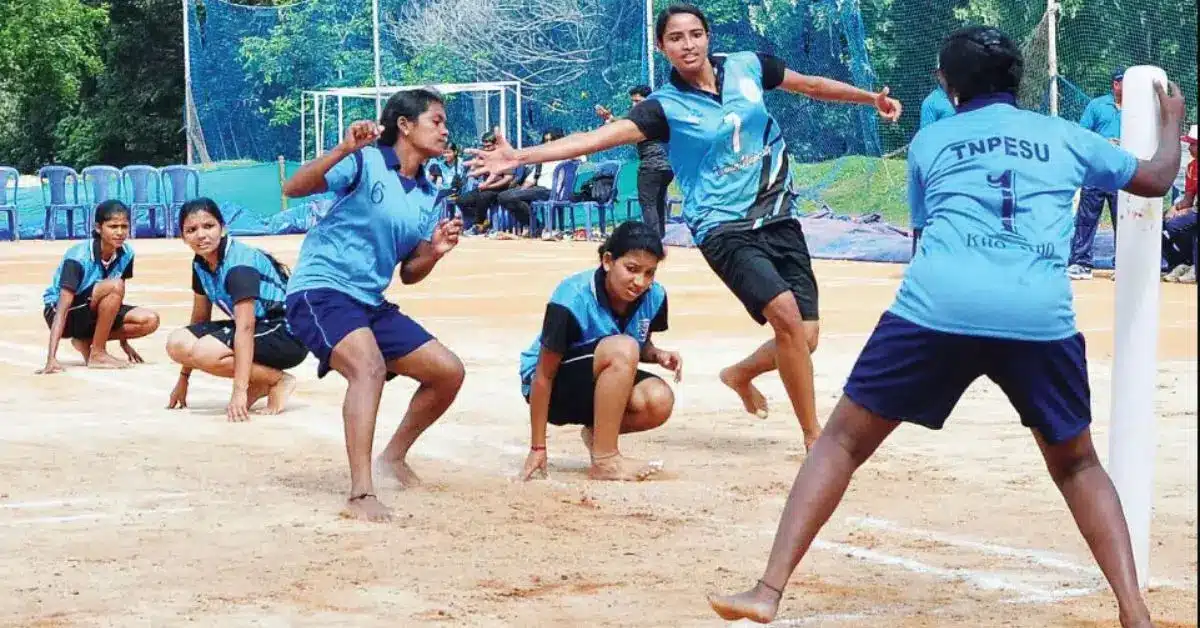Traditional Indian sport known as kho kho has existed for countless years in one form or another. Although it is difficult to pinpoint Kho Kho’s exact beginnings, it is thought that some elements of the game were described in the Mahabharata, an ancient Indian epic, specifically in the well-known Chakravyuha episode. In this blog, we are going to learn about the Kho Kho Game Terminology, Kho Kho rules, and more important information related to it.
Kho Kho Game Terminology
| Pole | At each end of the playing field, a sturdy wooden cylindrical structure was built specifically for the purpose. |
| Chaser | The member of the opposing team who is running is pursued by the side that is sitting. Chaser sit-in over crosslines with a different back in a square position. |
| Runner | the opponent’s player who avoids being pursued by the pursuer. |
| Central Lane | From one pole to the other, two parallel lines. |
| Cross Lane | The central line in the center of the playing area is cut by the parallel lanes. |
| Kho | The word “kho” is actually a pass that one chaser gives to another. |
| Early Getup | when the chaser who is seated gets up before receiving a Kho. |
| Late Kho | when a running chaser waits to touch another to give them the lead |
| Changing The Direction | when an active chaser violates the Kho Kho rules by moving against them. |
| Minus Kho | If Kho is not passed back to two teammates or makes contact with a pole, it is a violation of the rule that states that the player being chased cannot put the running player out. |
| Lobby | The free space area around the playfield. |
| Free Zone | A runner is free to move in any direction in the area next to the pole lines where the direction rule is not observed. |
| Square | A square-shaped area created by cutting the center and cross lanes was used for the chase’s seating. |
FURIOUS SHOAIB AKHTAR: INDIA FIXED THE GAME
ASIA CUP FINAL MATCH: A CLASH OF TITANS
Kho Kho Rules
(a) There are two teams, each with a total of 12 people. There are four 9-minute quarters or turns in the game.
(b) Only three members of the running team are on the field, while the eight members of the chasing team adopt a kneeling posture at a predetermined space between two poles on squares that have been marked through the field lines. Without crossing the line, they sit in the crosslane with their backs to one another. The ‘chaser’ member waits near one of the poles to initiate the initial pursuit of the runners.
(c) While the runners try to protect themselves from the chaser in order to avoid being touched, the chaser must touch or tap the runners. The game continues when the chaser touches all three runners; three additional runners (from the running team that is waiting in the entry zone area) join the field.
(d) While there are three runners on the field who can race inside a field range defined by two poles, the members of the pursuing team take up places on the cross-lane. The cross lane may be crossed by runners, and they may also alter their running direction.
(e) While pursuing the runners, the chaser is prohibited from running across the crosslane or changing lanes. He must touch the pole if necessary, then turn around and carry on pursuing.
(f) A point is given for each touch the chaser makes on a runner.
(g) Any other player seated may take the chaser’s turn by tapping them from behind while saying the word “Kho.”
(h) There are penalties for early Kho, touching without saying Kho, changing course while pursuing, cutting the cross lane, standing up without receiving a Kho, and late Kho.
(i) If there is a tie, there is an additional turn, and the one that takes the least amount of time to touch one runner from the opposing team is declared the winner.
How To Play Kho Kho
Similar to tag, the goal of Kho Kho is to tag or pursue an opponent to earn points. Instead of being a playground game where everything goes, it is constrained by a rigid set of Kho Kho rules.
Two innings in a senior international Kho Kho game are separated by a brief intermission. Teams rotate between chasing and defending during each of the two nine-minute turns in an inning. At the conclusion of the two innings, the team with the most points wins the game.
At the conclusion of the game, extra innings are played to determine the winner if the teams are tied. If there is still no clear winner, each team has a turn and the team that scores one point in the shortest amount of time wins.
Kho Kho Field Size
| Total area requirement | 30m x 19m (inclusive of the lobby from all sides measuring 1.5m wide.) |
| Playing Area | 27m x 16m inclusive of 1.5m x 16m of free zone behind both poles |
| Pole Distance | 24m Central lane joining two poles measuring 24m length x 30cm width |
| Cross lanes | 8 – intersecting the central lane. Each lane measuring 16m x 35m |
| Pole Size | Height (above ground level – 120cm to 125cm, Diameter 9-10cm) |
Conclusion
In this blog, we have discussed the kho kho and its terminology, Kho Kho Rules, and lots of more crucial information related to it.
